Kevin Wu
AutoRedTeamer: Autonomous Red Teaming with Lifelong Attack Integration
Mar 20, 2025Abstract:As large language models (LLMs) become increasingly capable, security and safety evaluation are crucial. While current red teaming approaches have made strides in assessing LLM vulnerabilities, they often rely heavily on human input and lack comprehensive coverage of emerging attack vectors. This paper introduces AutoRedTeamer, a novel framework for fully automated, end-to-end red teaming against LLMs. AutoRedTeamer combines a multi-agent architecture with a memory-guided attack selection mechanism to enable continuous discovery and integration of new attack vectors. The dual-agent framework consists of a red teaming agent that can operate from high-level risk categories alone to generate and execute test cases and a strategy proposer agent that autonomously discovers and implements new attacks by analyzing recent research. This modular design allows AutoRedTeamer to adapt to emerging threats while maintaining strong performance on existing attack vectors. We demonstrate AutoRedTeamer's effectiveness across diverse evaluation settings, achieving 20% higher attack success rates on HarmBench against Llama-3.1-70B while reducing computational costs by 46% compared to existing approaches. AutoRedTeamer also matches the diversity of human-curated benchmarks in generating test cases, providing a comprehensive, scalable, and continuously evolving framework for evaluating the security of AI systems.
FineTuneBench: How well do commercial fine-tuning APIs infuse knowledge into LLMs?
Nov 07, 2024



Abstract:There is great interest in fine-tuning frontier large language models (LLMs) to inject new information and update existing knowledge. While commercial LLM fine-tuning APIs from providers such as OpenAI and Google promise flexible adaptation for various applications, the efficacy of fine-tuning remains unclear. In this study, we introduce FineTuneBench, an evaluation framework and dataset for understanding how well commercial fine-tuning APIs can successfully learn new and updated knowledge. We analyze five frontier LLMs with commercially available fine-tuning APIs, including GPT-4o and Gemini 1.5 Pro, on their effectiveness in two settings: (1) ingesting novel information, such as recent news events and new people profiles, and (2) updating existing knowledge, such as updated medical guidelines and code frameworks. Our results reveal substantial shortcomings in all the models' abilities to effectively learn new information through fine-tuning, with an average generalization accuracy of 37% across all models. When updating existing knowledge, such as incorporating medical guideline updates, commercial fine-tuning APIs show even more limited capability (average generalization accuracy of 19%). Overall, fine-tuning GPT-4o mini is the most effective for infusing new knowledge and updating knowledge, followed by GPT-3.5 Turbo and GPT-4o. The fine-tuning APIs for Gemini 1.5 Flesh and Gemini 1.5 Pro are unable to learn new knowledge or update existing knowledge. These findings underscore a major shortcoming in using current commercial fine-tuning services to achieve reliable knowledge infusion in common scenarios. We open source the FineTuneBench dataset at https://github.com/kevinwu23/StanfordFineTuneBench.
How faithful are RAG models? Quantifying the tug-of-war between RAG and LLMs' internal prior
Apr 16, 2024



Abstract:Retrieval augmented generation (RAG) is often used to fix hallucinations and provide up-to-date knowledge for large language models (LLMs). However, in cases when the LLM alone incorrectly answers a question, does providing the correct retrieved content always fix the error? Conversely, in cases where the retrieved content is incorrect, does the LLM know to ignore the wrong information, or does it recapitulate the error? To answer these questions, we systematically analyze the tug-of-war between a LLM's internal knowledge (i.e. its prior) and the retrieved information in settings when they disagree. We test GPT-4 and other LLMs on question-answering abilities across datasets with and without reference documents. As expected, providing the correct retrieved information fixes most model mistakes (94% accuracy). However, when the reference document is perturbed with increasing levels of wrong values, the LLM is more likely to recite the incorrect, modified information when its internal prior is weaker but is more resistant when its prior is stronger. Similarly, we also find that the more the modified information deviates from the model's prior, the less likely the model is to prefer it. These results highlight an underlying tension between a model's prior knowledge and the information presented in reference documents.
How well do LLMs cite relevant medical references? An evaluation framework and analyses
Feb 03, 2024Abstract:Large language models (LLMs) are currently being used to answer medical questions across a variety of clinical domains. Recent top-performing commercial LLMs, in particular, are also capable of citing sources to support their responses. In this paper, we ask: do the sources that LLMs generate actually support the claims that they make? To answer this, we propose three contributions. First, as expert medical annotations are an expensive and time-consuming bottleneck for scalable evaluation, we demonstrate that GPT-4 is highly accurate in validating source relevance, agreeing 88% of the time with a panel of medical doctors. Second, we develop an end-to-end, automated pipeline called \textit{SourceCheckup} and use it to evaluate five top-performing LLMs on a dataset of 1200 generated questions, totaling over 40K pairs of statements and sources. Interestingly, we find that between ~50% to 90% of LLM responses are not fully supported by the sources they provide. We also evaluate GPT-4 with retrieval augmented generation (RAG) and find that, even still, around 30\% of individual statements are unsupported, while nearly half of its responses are not fully supported. Third, we open-source our curated dataset of medical questions and expert annotations for future evaluations. Given the rapid pace of LLM development and the potential harms of incorrect or outdated medical information, it is crucial to also understand and quantify their capability to produce relevant, trustworthy medical references.
DataInf: Efficiently Estimating Data Influence in LoRA-tuned LLMs and Diffusion Models
Oct 02, 2023Abstract:Quantifying the impact of training data points is crucial for understanding the outputs of machine learning models and for improving the transparency of the AI pipeline. The influence function is a principled and popular data attribution method, but its computational cost often makes it challenging to use. This issue becomes more pronounced in the setting of large language models and text-to-image models. In this work, we propose DataInf, an efficient influence approximation method that is practical for large-scale generative AI models. Leveraging an easy-to-compute closed-form expression, DataInf outperforms existing influence computation algorithms in terms of computational and memory efficiency. Our theoretical analysis shows that DataInf is particularly well-suited for parameter-efficient fine-tuning techniques such as LoRA. Through systematic empirical evaluations, we show that DataInf accurately approximates influence scores and is orders of magnitude faster than existing methods. In applications to RoBERTa-large, Llama-2-13B-chat, and stable-diffusion-v1.5 models, DataInf effectively identifies the most influential fine-tuning examples better than other approximate influence scores. Moreover, it can help to identify which data points are mislabeled.
Explaining medical AI performance disparities across sites with confounder Shapley value analysis
Nov 12, 2021



Abstract:Medical AI algorithms can often experience degraded performance when evaluated on previously unseen sites. Addressing cross-site performance disparities is key to ensuring that AI is equitable and effective when deployed on diverse patient populations. Multi-site evaluations are key to diagnosing such disparities as they can test algorithms across a broader range of potential biases such as patient demographics, equipment types, and technical parameters. However, such tests do not explain why the model performs worse. Our framework provides a method for quantifying the marginal and cumulative effect of each type of bias on the overall performance difference when a model is evaluated on external data. We demonstrate its usefulness in a case study of a deep learning model trained to detect the presence of pneumothorax, where our framework can help explain up to 60% of the discrepancy in performance across different sites with known biases like disease comorbidities and imaging parameters.
Synthesizing lesions using contextual GANs improves breast cancer classification on mammograms
May 29, 2020



Abstract:Data scarcity and class imbalance are two fundamental challenges in many machine learning applications to healthcare. Breast cancer classification in mammography exemplifies these challenges, with a malignancy rate of around 0.5% in a screening population, which is compounded by the relatively small size of lesions (~1% of the image) in malignant cases. Simultaneously, the prevalence of screening mammography creates a potential abundance of non-cancer exams to use for training. Altogether, these characteristics lead to overfitting on cancer cases, while under-utilizing non-cancer data. Here, we present a novel generative adversarial network (GAN) model for data augmentation that can realistically synthesize and remove lesions on mammograms. With self-attention and semi-supervised learning components, the U-net-based architecture can generate high resolution (256x256px) outputs, as necessary for mammography. When augmenting the original training set with the GAN-generated samples, we find a significant improvement in malignancy classification performance on a test set of real mammogram patches. Overall, the empirical results of our algorithm and the relevance to other medical imaging paradigms point to potentially fruitful further applications.
Robust breast cancer detection in mammography and digital breast tomosynthesis using annotation-efficient deep learning approach
Dec 27, 2019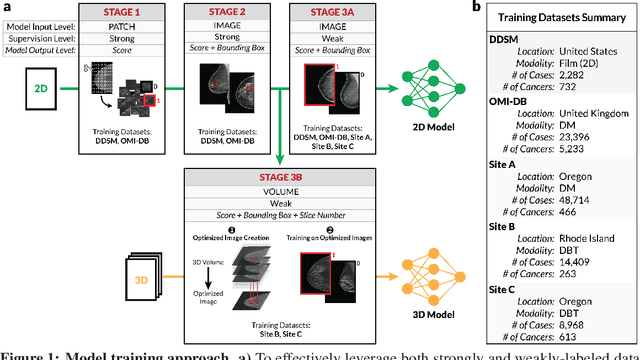
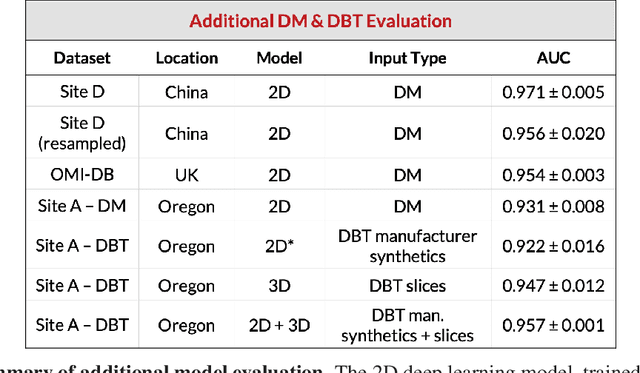
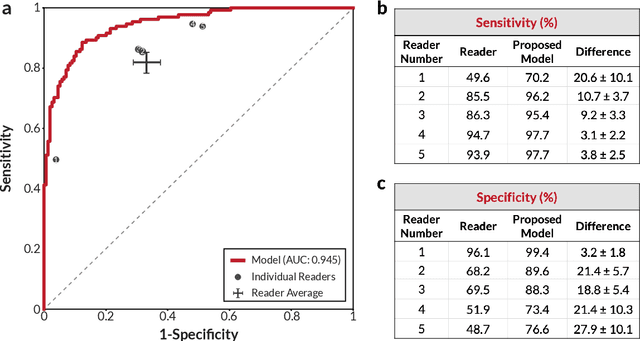
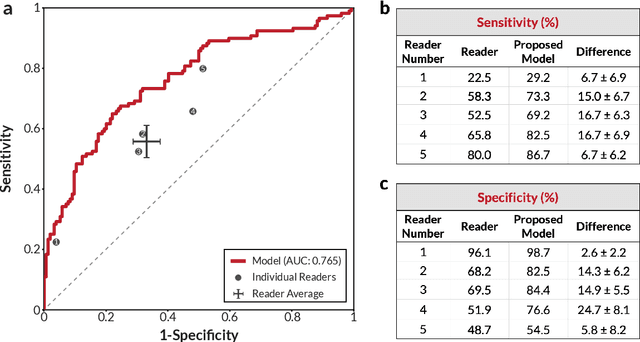
Abstract:Breast cancer remains a global challenge, causing over 1 million deaths globally in 2018. To achieve earlier breast cancer detection, screening x-ray mammography is recommended by health organizations worldwide and has been estimated to decrease breast cancer mortality by 20-40%. Nevertheless, significant false positive and false negative rates, as well as high interpretation costs, leave opportunities for improving quality and access. To address these limitations, there has been much recent interest in applying deep learning to mammography; however, obtaining large amounts of annotated data poses a challenge for training deep learning models for this purpose, as does ensuring generalization beyond the populations represented in the training dataset. Here, we present an annotation-efficient deep learning approach that 1) achieves state-of-the-art performance in mammogram classification, 2) successfully extends to digital breast tomosynthesis (DBT; "3D mammography"), 3) detects cancers in clinically-negative prior mammograms of cancer patients, 4) generalizes well to a population with low screening rates, and 5) outperforms five-out-of-five full-time breast imaging specialists by improving absolute sensitivity by an average of 14%. Our results demonstrate promise towards software that can improve the accuracy of and access to screening mammography worldwide.
Validation of a deep learning mammography model in a population with low screening rates
Nov 01, 2019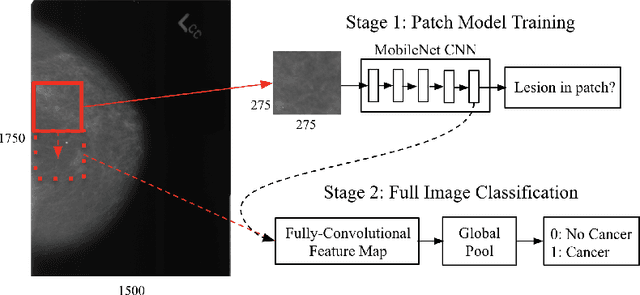
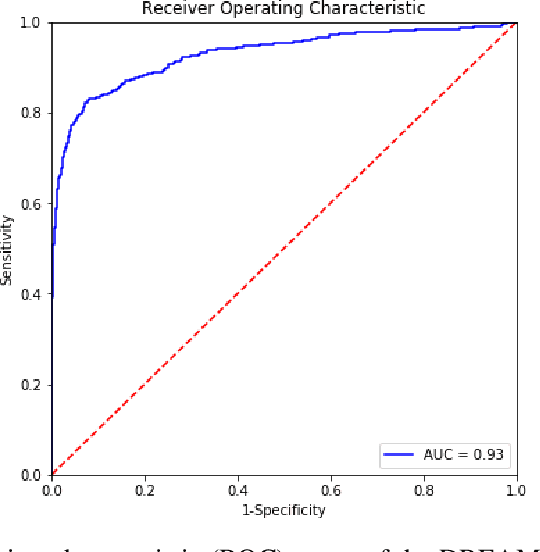
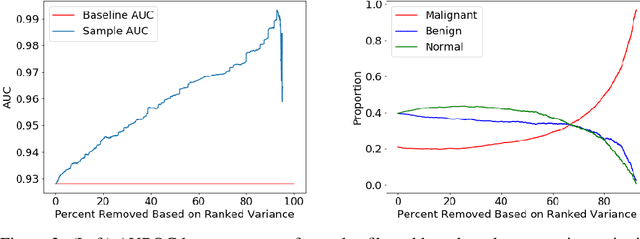
Abstract:A key promise of AI applications in healthcare is in increasing access to quality medical care in under-served populations and emerging markets. However, deep learning models are often only trained on data from advantaged populations that have the infrastructure and resources required for large-scale data collection. In this paper, we aim to empirically investigate the potential impact of such biases on breast cancer detection in mammograms. We specifically explore how a deep learning algorithm trained on screening mammograms from the US and UK generalizes to mammograms collected at a hospital in China, where screening is not widely implemented. For the evaluation, we use a top-scoring model developed for the Digital Mammography DREAM Challenge. Despite the change in institution and population composition, we find that the model generalizes well, exhibiting similar performance to that achieved in the DREAM Challenge, even when controlling for tumor size. We also illustrate a simple but effective method for filtering predictions based on model variance, which can be particularly useful for deployment in new settings. While there are many components in developing a clinically effective system, these results represent a promising step towards increasing access to life-saving screening mammography in populations where screening rates are currently low.
Mixed Membership Recurrent Neural Networks
Dec 23, 2018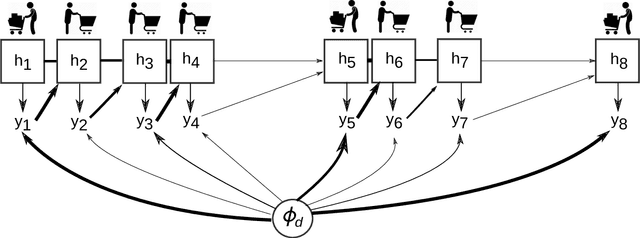
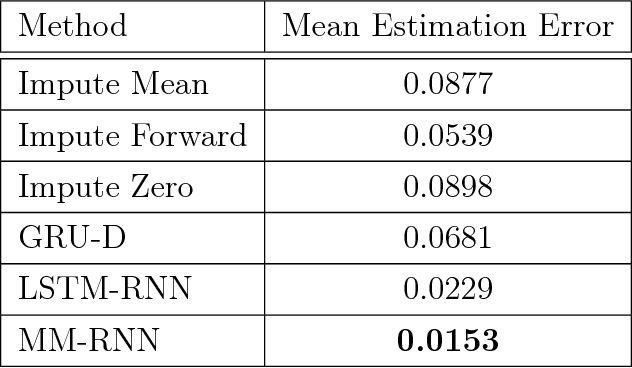
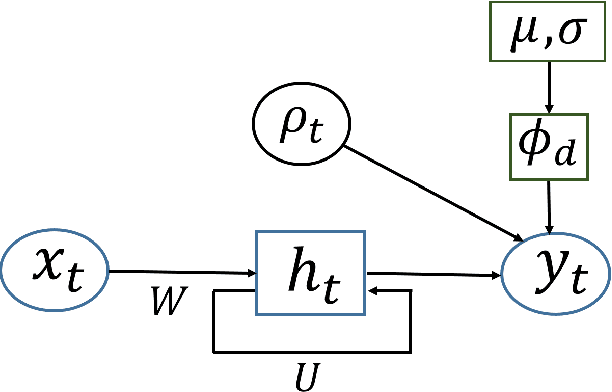
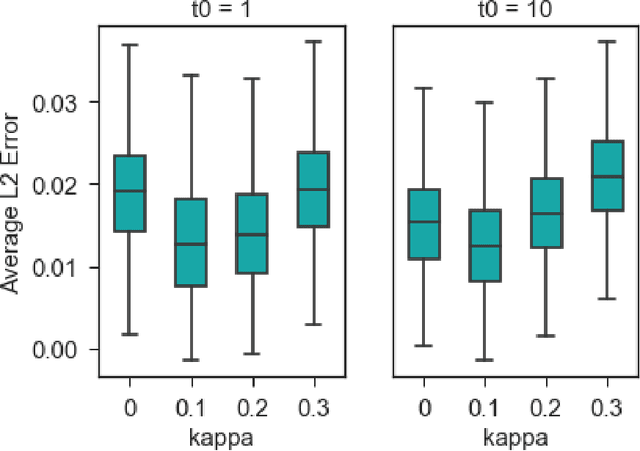
Abstract:Models for sequential data such as the recurrent neural network (RNN) often implicitly model a sequence as having a fixed time interval between observations and do not account for group-level effects when multiple sequences are observed. We propose a model for grouped sequential data based on the RNN that accounts for varying time intervals between observations in a sequence by learning a group-level base parameter to which each sequence can revert. Our approach is motivated by the mixed membership framework, and we show how it can be used for dynamic topic modeling in which the distribution on topics (not the topics themselves) are evolving in time. We demonstrate our approach on a dataset of 3.4 million online grocery shopping orders made by 206K customers.
 Add to Chrome
Add to Chrome Add to Firefox
Add to Firefox Add to Edge
Add to Edge